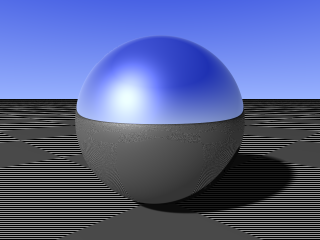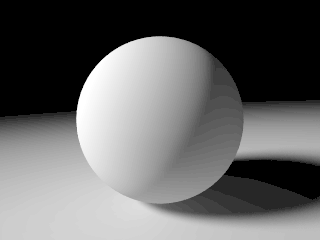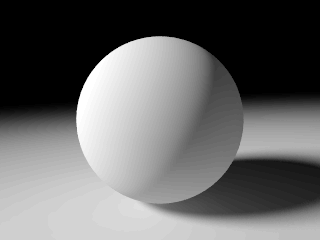Difference between revisions of "User:Clipka/Gamma"
| Line 10: | Line 10: | ||
However, wherever the engine interfaces to the "outside world"—whether generating the output image file, submitting preview window content to the operating system for display, loading some input image for texturing, or just having the user enter color values picked from some other application—a raytracing software package has to account for the "gamma issue", or the output will still be just as wrong: Input colors will not be interpreted as intended, and the output image will not appear as computed. | However, wherever the engine interfaces to the "outside world"—whether generating the output image file, submitting preview window content to the operating system for display, loading some input image for texturing, or just having the user enter color values picked from some other application—a raytracing software package has to account for the "gamma issue", or the output will still be just as wrong: Input colors will not be interpreted as intended, and the output image will not appear as computed. | ||
| + | |||
| + | == Perceptual Brightness and Gamma Encoding == | ||
| + | |||
| + | [[File:Gamma_encoding_g10.png|right|frame|This image has suffered 6-bit ''linear'' encoding. Notice the particularly strong color banding in the shadow.]] | ||
| + | |||
| + | [[File:Gamma_encoding_g22.png|right|frame|With 6-bit ''gamma'' encoding instead (using a gamma of 2.2), all brightness levels suffer a roughly equal share of color banding.]] | ||
| + | |||
| + | You may wonder why pixel values represent brightness levels (and thus colors) in such a strongly non-linear fashion—and why you probably never noticed before. However, if you have read the introduction carefully you may already guess the answer to the second question, and it in fact is also the answer to the first one: The "pixel value way" of encoding brightness levels—known as ''gamma encoding''—is much closer to how a human observer percieves brightness levels. For instance, while a human can easily distinguish a 1%-intensity grey from a 0%-intensity black, he is perfectly unable to tell a 99%-intensity grey from a 100%-intensity white. As a result, gamma encoding can get away with a lower bit depth than linear encoding. | ||
| + | |||
| + | To get the history straight, this is probably not the main reason why gamma encoding was originally ''invented''. Instead, it has always been around ever since the first use of multiple brightness levels in computer displays, and is more likely due to the inherent power-law response curve of CRT displays—known as ''display gamma''—that just happened to fit quite well with the peculiarities of human vision. To save on hardware complexity, the graphics adaptor would use linear ADCs to convert framebuffer data to signal voltages for the display, which in turn would more or less directly drive its CRT from these signals; as a consequence, the framebuffer content would have to be pre-corrected for the CRT's inherent gamma. It is these ''gamma pre-corrected'' values that constitute the pixel values omnipresent in image processing. | ||
| + | |||
| + | It should come as no surprise that image formats have always been using gamma encoding, as it both allowed to keep image viewing software simple (all the software would have to do was read the image file and copy the data to the framebuffer), ''and'' to obtain a better overall visual quality than linear encoding could achieve at the same bit depth. | ||
| + | |||
| + | Traditionally, gamma encoding (or pre-correction, for that matter) is performed using a simple power-law, i.e.: | ||
| + | :<math>f(x)\!\,=x^{\gamma}</math> | ||
| + | where <math>\gamma</math> may be either of: | ||
| + | * the ''encoding gamma'' when encoding; | ||
| + | * the ''inverse'' of the encoding gamma when decoding, also referred to as the ''decoding gamma''; | ||
| + | * the ''inverse'' of the ''display gamma'' when performing display gamma pre-correction. | ||
| + | A typical display gamma is somewhere around 2.2 on PC systems, and 1.8 on older Mac systems (prior to Mac OS X 10.6), but on uncalibrated systems the exact value depends on the graphics card, display, and even the display settings like brightness and contrast. A typical decoding gamma is, not surprisingly, in the same order of magnitude, while a typical encoding gamma is consequently around 0.45 (=1/2.2). | ||
| + | |||
| + | More generically, such encoding/decoding (and pre-correcting) functions are referred to as ''transfer functions''; besides the power-law gamma function, another commonly used one is the ''sRGB transfer function'', which can roughly be approximated by a classic power-law function with a gamma of 2.2, but has slightly superior properties at low brightness levels. As the sRGB color space is officially recommended as the default for the World Wide Web, its transfer function can be considered the de-facto standard for virtually all major file formats. | ||
| + | |||
| + | An exception to this are ''high dynamic range'' image file formats. Their use of floating-point or floating-point-alike number formats provide them with an inherently adaptive bit depth anyway, so gamma encoding gives no benefits to these formats. Typically, such formats are therefore explicitly defined to store linear light intensity levels, avoiding both unnecessary processing steps and potential confusion. | ||
== Why Should I Care? == | == Why Should I Care? == | ||
Revision as of 01:47, 6 November 2009
What is this Gamma Thing All About?
In short, the whole "gamma issue" is about nonlinearity in image processing, regarding how intermediate brightness levels between 0% and 100% are interpreted.
To let you take a first brief glimpse at the can of worms we're about to open: A standard 8-bit image file has pixel values ranging from 0 to 255, equivalent to 0% and 100% brightness respectively. So what brightness would you expect for a value of 128? Well, 50%, right? Wrong. A meager 22% is usually closer to the mark. Or 20%, or 25%, or whatever exactly your system happens to make of it. Unless we're talking about percieved brightness: A physical light intensity of 22% actually looks surprisingly bright, and an observer may percieve it as something around 45% in between black and white. Depending on ambient viewing conditions, just to make matters worse.
For a raytracing engine, linear physical light intensity is the only useful internal representation of intermediate brightness values, as it is in this domain that computations can be performed most efficiently; and any attempt to apply the same math in some other domain will produce inconsistencies in the output, which will usually be subtle enough to be unable to pinpoint them, yet obvious enough for an observer to somehow sense that something is wrong.
However, wherever the engine interfaces to the "outside world"—whether generating the output image file, submitting preview window content to the operating system for display, loading some input image for texturing, or just having the user enter color values picked from some other application—a raytracing software package has to account for the "gamma issue", or the output will still be just as wrong: Input colors will not be interpreted as intended, and the output image will not appear as computed.
Perceptual Brightness and Gamma Encoding
You may wonder why pixel values represent brightness levels (and thus colors) in such a strongly non-linear fashion—and why you probably never noticed before. However, if you have read the introduction carefully you may already guess the answer to the second question, and it in fact is also the answer to the first one: The "pixel value way" of encoding brightness levels—known as gamma encoding—is much closer to how a human observer percieves brightness levels. For instance, while a human can easily distinguish a 1%-intensity grey from a 0%-intensity black, he is perfectly unable to tell a 99%-intensity grey from a 100%-intensity white. As a result, gamma encoding can get away with a lower bit depth than linear encoding.
To get the history straight, this is probably not the main reason why gamma encoding was originally invented. Instead, it has always been around ever since the first use of multiple brightness levels in computer displays, and is more likely due to the inherent power-law response curve of CRT displays—known as display gamma—that just happened to fit quite well with the peculiarities of human vision. To save on hardware complexity, the graphics adaptor would use linear ADCs to convert framebuffer data to signal voltages for the display, which in turn would more or less directly drive its CRT from these signals; as a consequence, the framebuffer content would have to be pre-corrected for the CRT's inherent gamma. It is these gamma pre-corrected values that constitute the pixel values omnipresent in image processing.
It should come as no surprise that image formats have always been using gamma encoding, as it both allowed to keep image viewing software simple (all the software would have to do was read the image file and copy the data to the framebuffer), and to obtain a better overall visual quality than linear encoding could achieve at the same bit depth.
Traditionally, gamma encoding (or pre-correction, for that matter) is performed using a simple power-law, i.e.:
where may be either of:
- the encoding gamma when encoding;
- the inverse of the encoding gamma when decoding, also referred to as the decoding gamma;
- the inverse of the display gamma when performing display gamma pre-correction.
A typical display gamma is somewhere around 2.2 on PC systems, and 1.8 on older Mac systems (prior to Mac OS X 10.6), but on uncalibrated systems the exact value depends on the graphics card, display, and even the display settings like brightness and contrast. A typical decoding gamma is, not surprisingly, in the same order of magnitude, while a typical encoding gamma is consequently around 0.45 (=1/2.2).
More generically, such encoding/decoding (and pre-correcting) functions are referred to as transfer functions; besides the power-law gamma function, another commonly used one is the sRGB transfer function, which can roughly be approximated by a classic power-law function with a gamma of 2.2, but has slightly superior properties at low brightness levels. As the sRGB color space is officially recommended as the default for the World Wide Web, its transfer function can be considered the de-facto standard for virtually all major file formats.
An exception to this are high dynamic range image file formats. Their use of floating-point or floating-point-alike number formats provide them with an inherently adaptive bit depth anyway, so gamma encoding gives no benefits to these formats. Typically, such formats are therefore explicitly defined to store linear light intensity levels, avoiding both unnecessary processing steps and potential confusion.
Why Should I Care?
Even as a POV-Ray beginner, you'll possibly care about the general phenomenon: The 50% vs. 22% vs. 45% thing - pixel values and perceptual brightness vs. physical light intensity. These differences have two major implications for you:
- Colors you pick in Photoshop (or Gimp or whatever your favorite image processing software may be) will not seem to work in POV-Ray as expected; grey-ish colors will simply appear too bright, while more colorful ones will appear washed out, or even off hue (this is because the nonlinearity affects each color component individually).
- When trying to achieve a certain brightness level, you may have difficulties getting the level right at first attempt.
As an advanced POV-Ray user, you may also worry about different systems exhibiting more or less subtle differences in the nonlinearity:
- The same image file may display differently on a friend's computer. Or the new LCD you're about to buy. Or the machine you're running your overnight renders on. Or the computers of the jurors of that internet ray tracing competition you're taking part in. You probably want to make sure they can see the barely-lit creature lurking in your nighttime scene, or that your daytime scene doesn't look too washed-out on their displays. Presuming they have done their own gamma homework of course.
- You want to be sure that the scene you share across the internet renders on the recipient's computer just as it does on your own.
So What Can I Do About Those Color Picking Issues?
When picking pixel values from Photoshop (or whatever you have), you can use the following formula to compute the color parameters to use in your POV-Ray scene file:
If you frequently pick colors, you may also want to define a macro to do the job:
#macro PickedRGB(R,G,B)
#local Red = pow(R/255, 2.2);
#local Green = pow(G/255, 2.2);
#local Blue = pow(B/255, 2.2);
rgb <Red,Green,Blue>
#end
#local MyColor = color PickedRGB(255,128,0);
If you generally feel more at home with defining colors by pixel values rather than physical brightness levels, you can use the same macro of course for all your colors, not just those you picked from some image-editing application.
Why Does POV-Ray Not Do it The Photoshop Way?
With raytracing being essentially an attempt to simulate the physical interaction of light rays with object surfaces and media, it should come as no surprise that the math behind it is easiest (and fastest) when brightness levels are expressed as physical light intensity, rather than perceptual brightness (which varies with viewing conditions anyway) or the more or less arbitrary concept of pixel values (which we'll go into detail later). To get realistic results at reasonable speed, a raytracing system must do virtually all its internal computations with physical light intensity.
Still, in theory this would not stop us from having the user specify all colors by pixel values, and automatically convert to physical light intensity just as the macro above does. So why does POV-Ray not do it?
The answer lies in the power of the scene description language: You can do too much with colors in POV-Ray's SDL that it is practically imposible to come up with a watertight automatism of identifying which non-color value specified in a scene file will wind up being interpeted as a color nonetheless (and therefore would have to be subject to conversion), which color value will end up being interpreted as a non-color (and therefore would have to be exempt from conversion), and whether some mathematical operation on colors should be performed in the pixel value domain or in the light intensity domain instead.
POV-Ray's philosophy therefore is to always presume colors to be expressed by linear light intensity values, and leave it up to the user to explicitly specify when and where conversions are to be applied.
So What Can I Do About Those System-Dependent Differences?
In a nutshell, the answer is: Calibrate your system, and encourage others to do the same.





